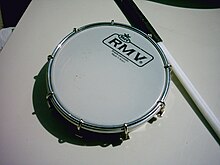Tamborim
The tamborim is a small drum without a resonance body from the Brazilian samba percussion . It is not to be confused with the more widely used tambourine . Depending on the music style, the tones on the tamborim are produced with fingers, light wooden sticks (sometimes common drum sticks ) or plastic whips ( baqueta ).
commitment
As a percussive accompanying instrument in choro , pagoda and generally the Música Popular Brasileira , the tamborim is used rather quietly. The pattern played is mostly based on the rhythmic structure of the Partido Alto , but is varied very freely and goes with the accents and melody structure of the piece. Sometimes several tamborims with different moods are used, each with a different pattern.
For the Samba Batucada , several tamborims with plastic whips are often played. This creates a very distinctive, sharp tone. A playing technique called "virado", a turning movement of the left hand that holds the tamborim, makes it possible to play very quickly. This means that continuous 16th notes can be played even at the high tempo of the Samba Batucada. The sound of the tamborims “floats” over the music of the Batucada; they accentuate and structure the piece.
The size and weight of tamborims are comparable to small frame drums from the Orff instrument range . Simple rhythms are easy to learn even for smaller children. Therefore, the Tamborim is also a (significantly louder) alternative to the frame drums.
See also
literature
- Oscar Bolão: Batuque É To Privilégio. 3. Edition. Lumiar, Rio de Janeiro 2013, ISBN 978-85-85426-85-9 , pp. 34–36, 64–65 ( limited preview in Google book search).
- Vina Lacerda: Instrumentos e ritmos brasileiros. Brazilian instruments and rhythms. [Self-published], Curitiba 2014, ISBN 978-85-907895-2-9
Web links
- Tamborim. In: www.percussionista.com.brr. Percussionista(Portuguese).
Individual evidence
- ↑ Guilherme Bartz: Os instrumentos da bateria nas escolas de samba ( Memento of March 13, 2016 in the Internet Archive ), Estação Musical.
- ↑ Oscar Bolão: Batuque É To PRIVILEGIO. 2013, p. 36.


